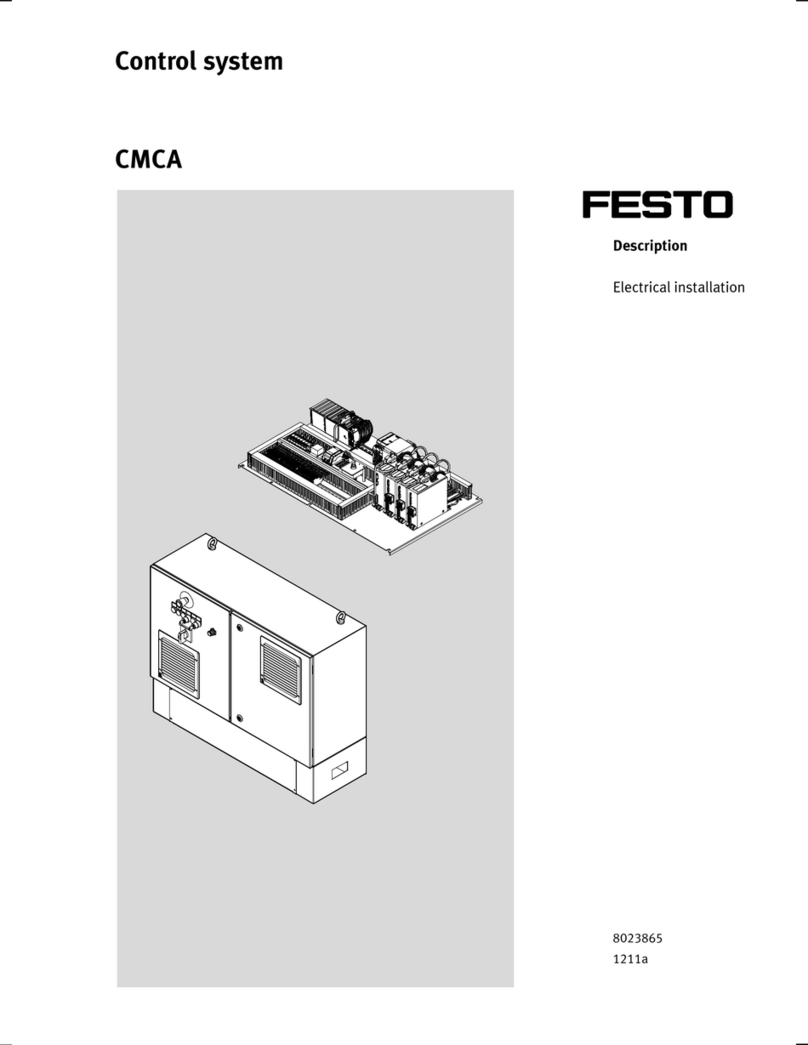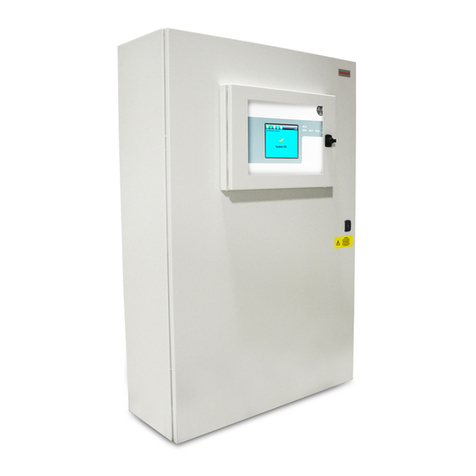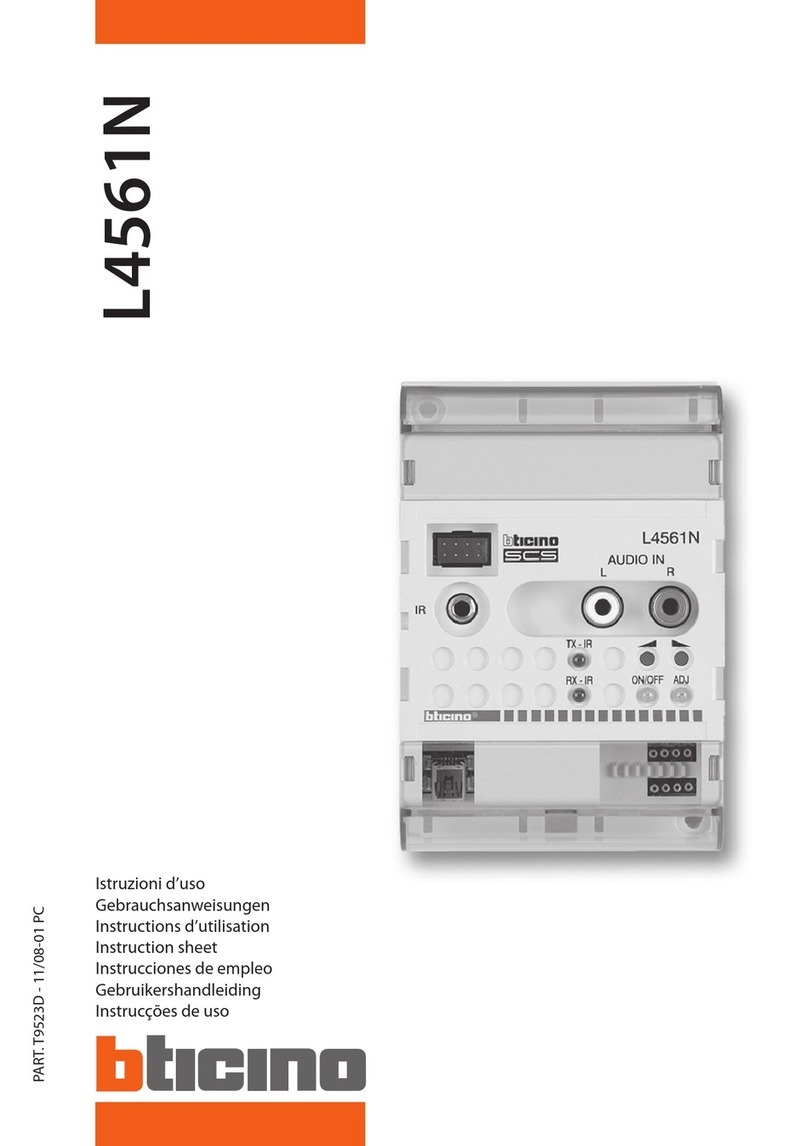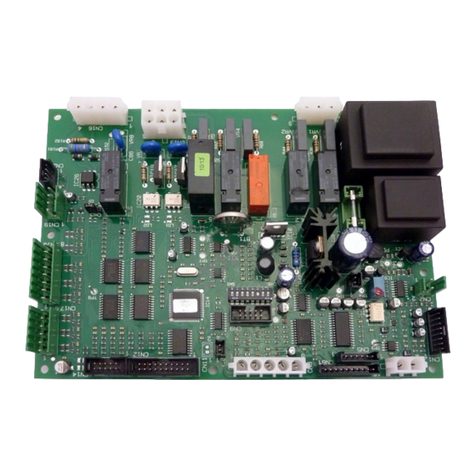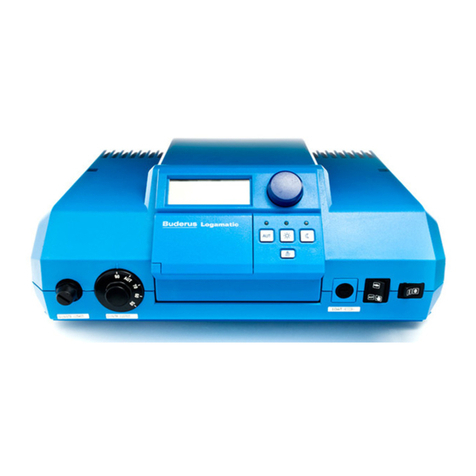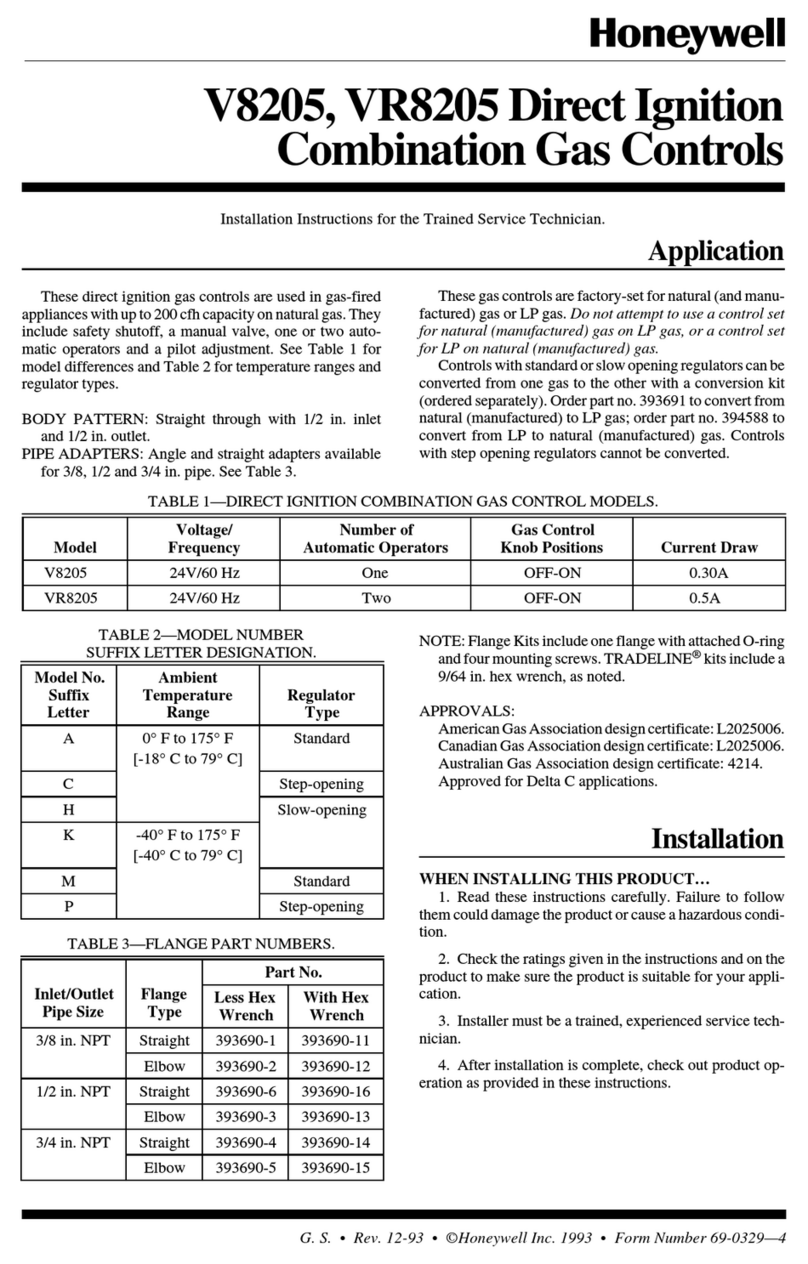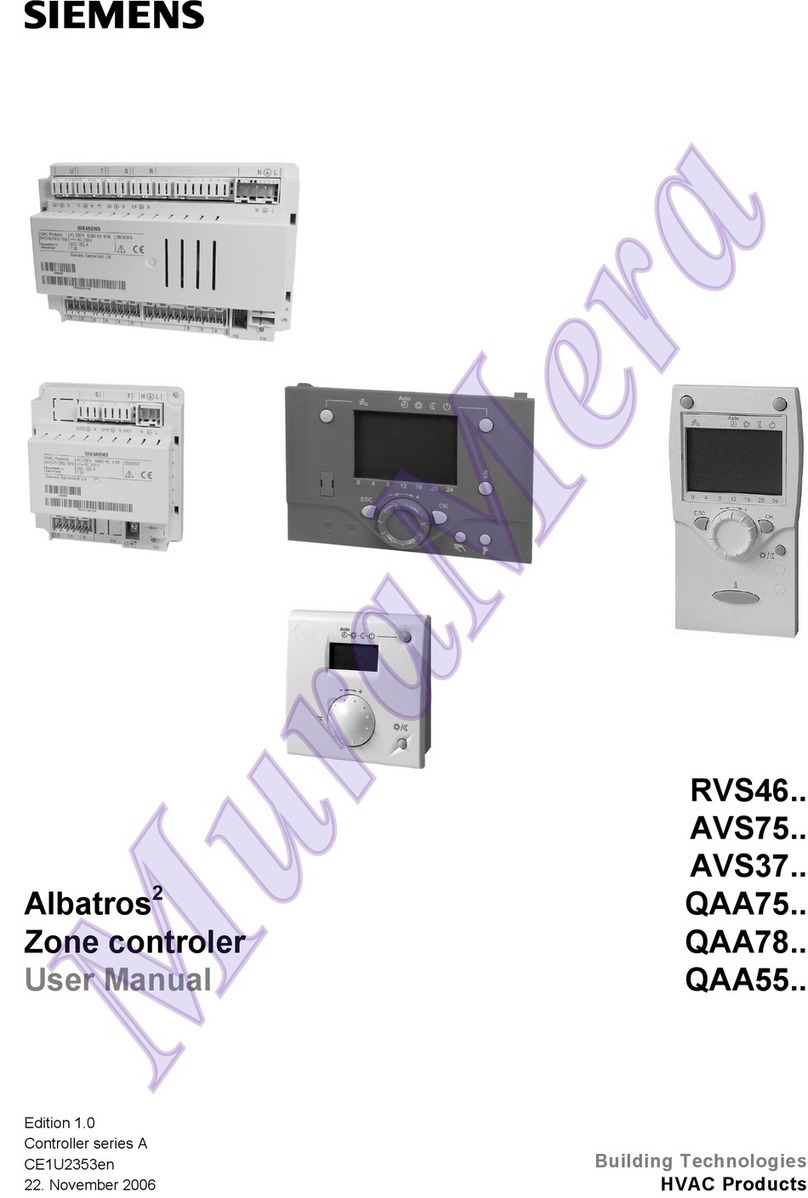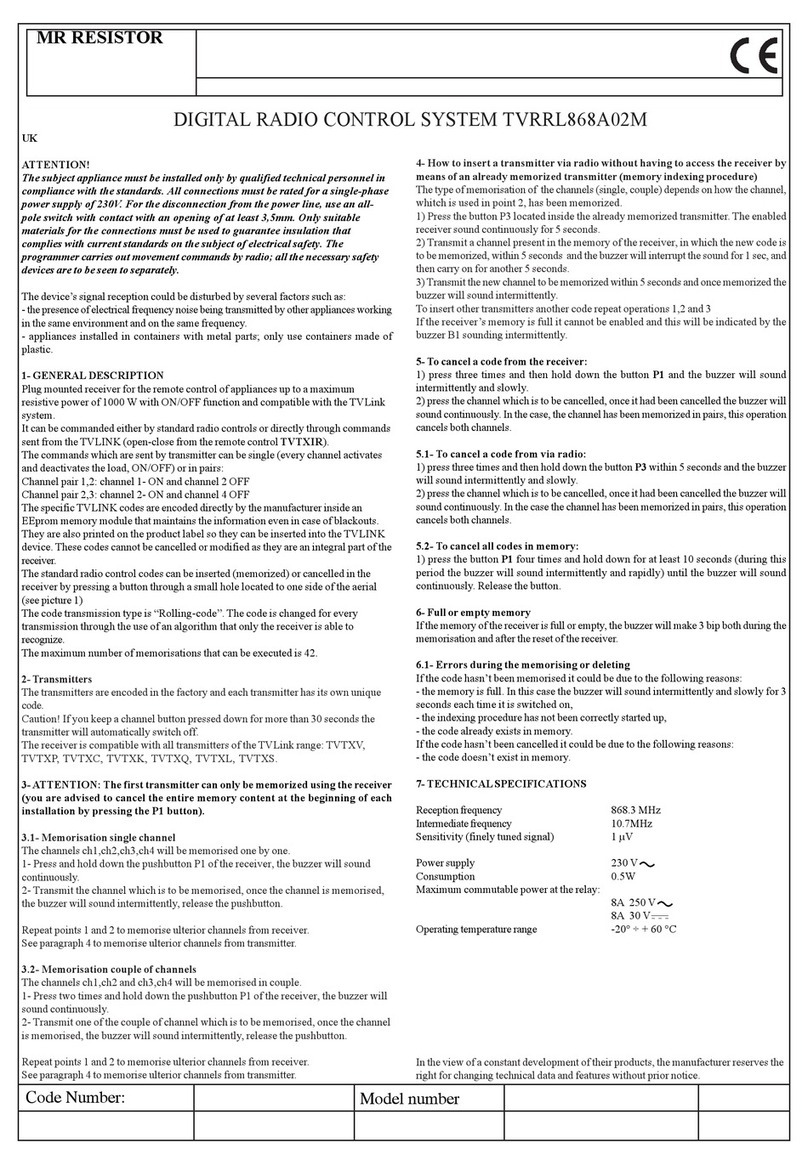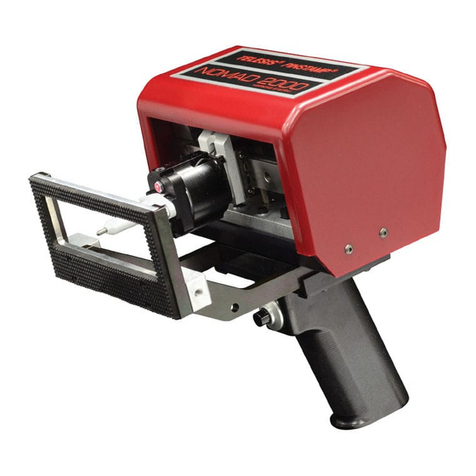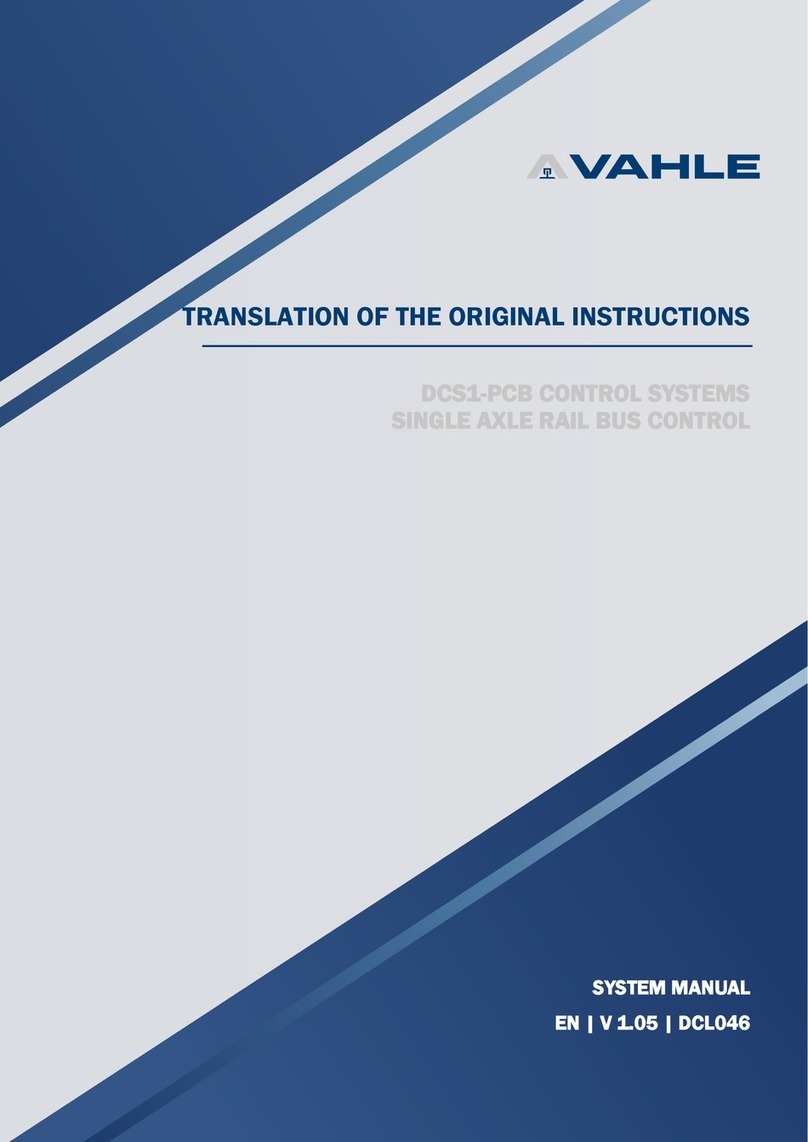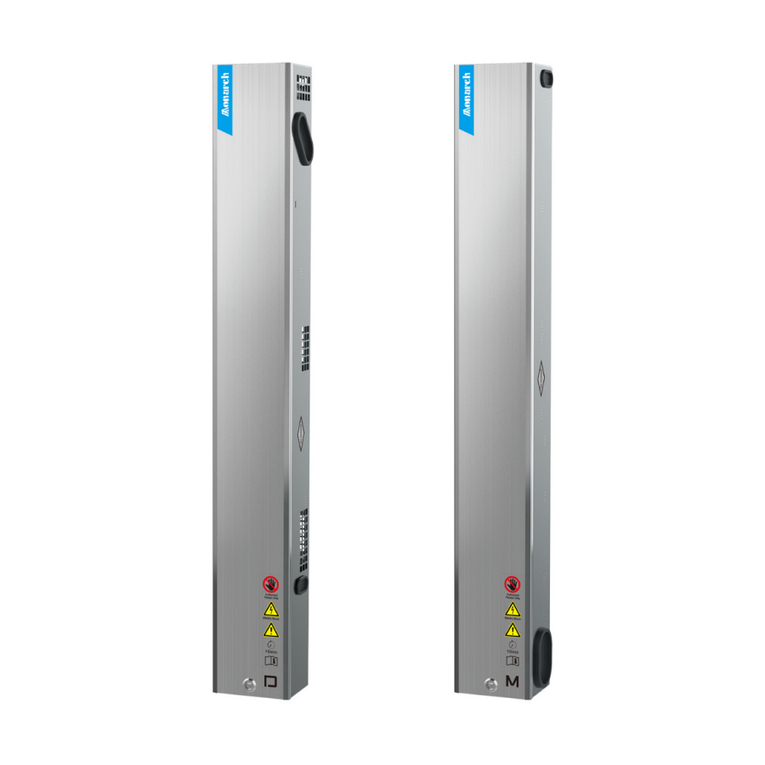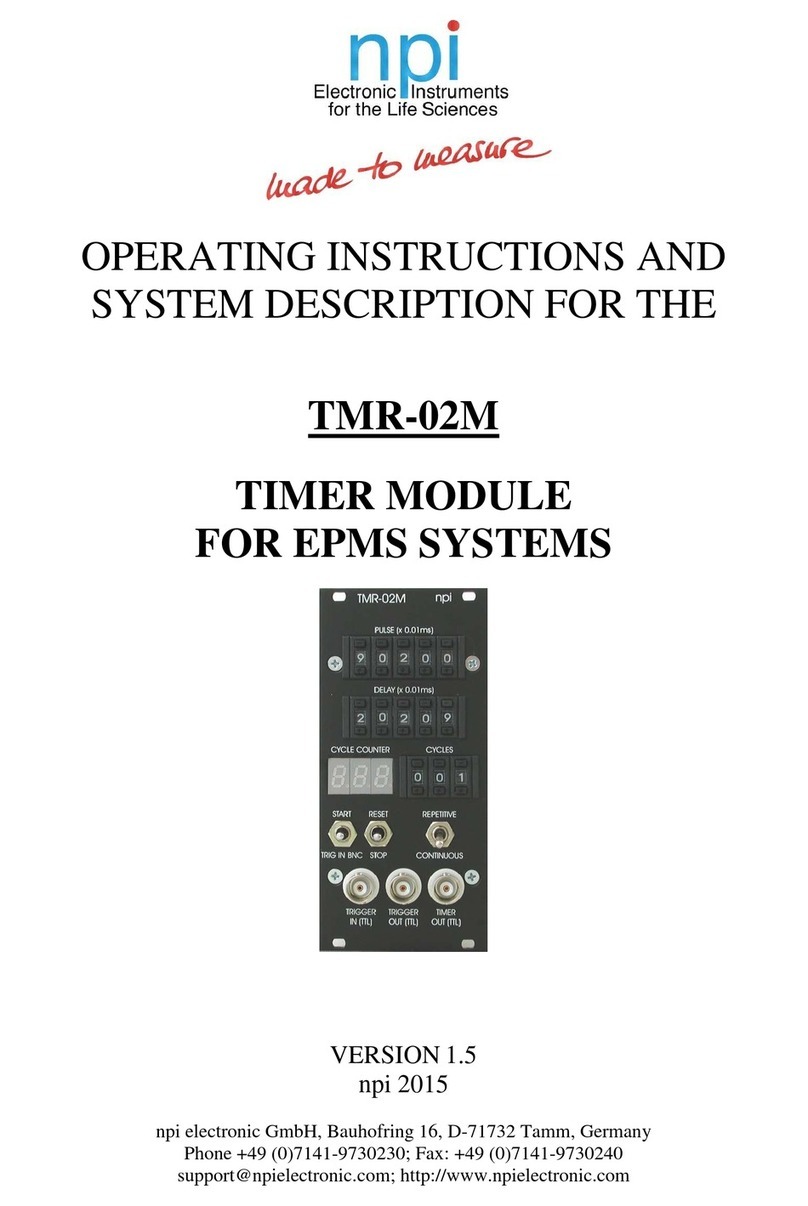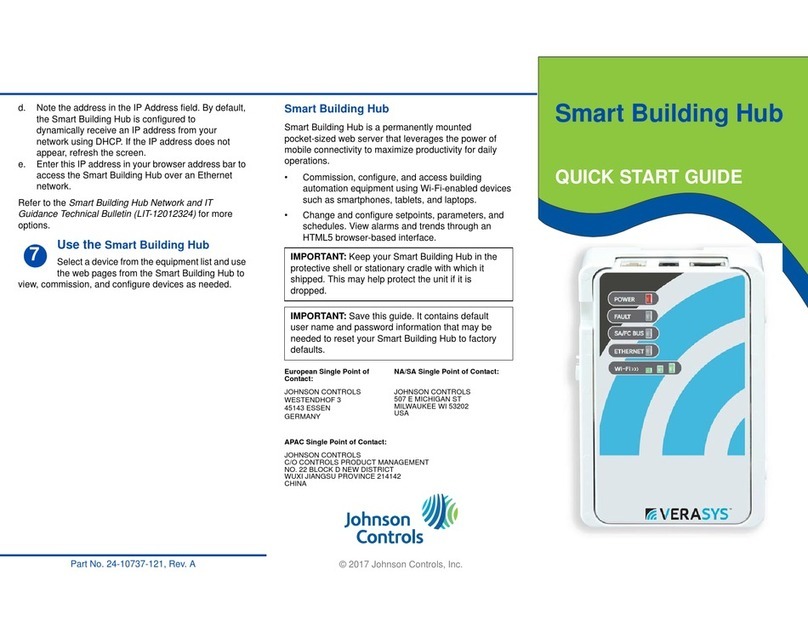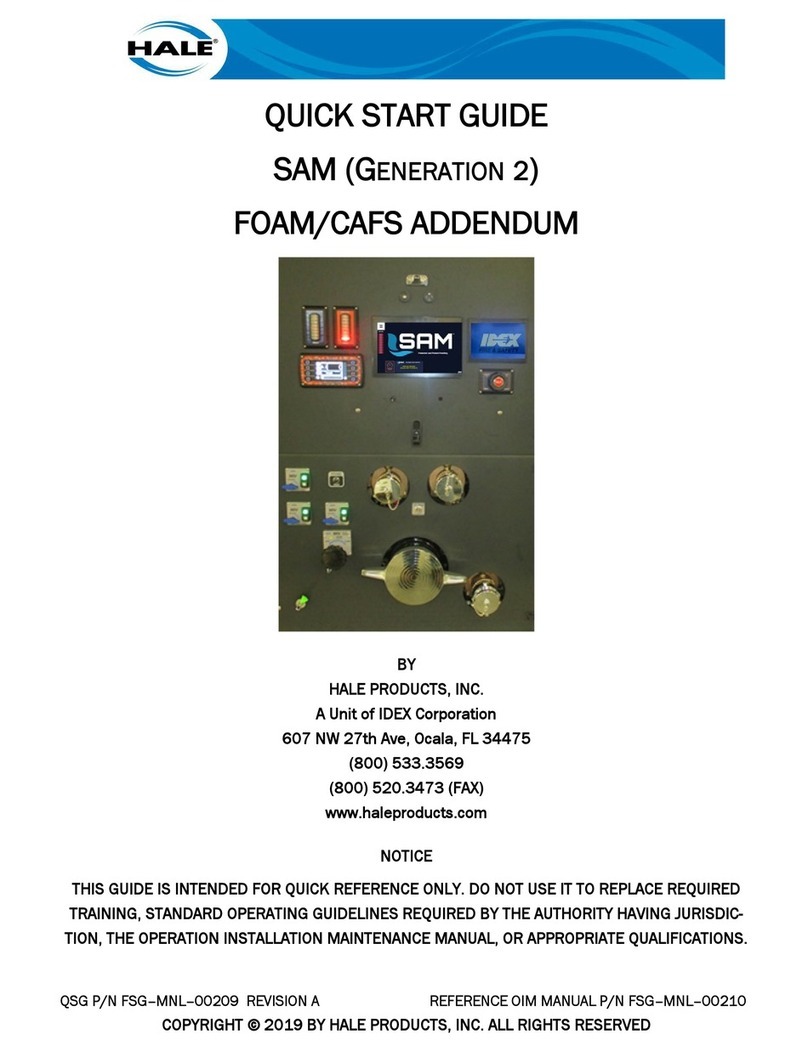Festo CPX-E Parts list manual

Translation of the original instructions
© 2020 all rights reserved to Festo SE & Co. KG
1 About this document
This document describes the use of the above-mentioned product family.
Certain aspects of use are described in other documents and must be observed
è 1.1 Applicable Documents.
1.1 Applicable Documents
All available documents for the product èwww.festo.com/pk.
Document Contents
Description of the automation system CPX-E
(CPX-E-SYS)
Detailed description of the
automation system CPX-E
Documentation of the components in an
automation system CPX-E and the connected
peripherals
Information on using the components
Operating conditions EX Information on the use of the product in poten-
tially explosive gas atmospheres
Device description files Definition of the modules of an
automation system CPX-E for integration into the
higher-order controller
Documentation for the higher-order controller
and the additional participants in the network
Information on commissioning and paramet-
erisation of the components
Tab. 1 Applicable Documents
1.2 Product version
This document refers to the automation system CPX-E with CPX-E modules.
The product version can be identified from the product labelling or with the help
of appropriate software from Festo.
Appropriate software for determining the product version can be found in the
Festo Support Portal èwww.festo.com/sp.
Information on using the software can be found in the integrated Help function.
1.3 Product labelling
The CPX-E modules are labelled on the left lateral surface. The product labelling is
described in the documentation supplied with the product.
1.4 Specified standards
Version status
DIN46228-1:1992-08 EN60529:2013-10
DIN46228-4:1990-09 EN60715:2001-09
EN60068-2-27:2010-02 IEC60204-1:2014-10
Tab. 2 Standards specified in the document
1.5 UL/CSA Certification
In combination with the UL inspection mark on the product, the information in this
section must also be observed in order to comply with the certification conditions
of Underwriters Laboratories Inc. (UL) for USA and Canada.
UL certification information
Product category code NRAQ/NRAQ7
File number E239998
UL certification information
Considered standards UL 61010-1, 3rd Edition, May 11, 2012, revised April 29, 2016
CAN/CSA-C22.2 No. 61010-1-12, 3rd Edition, revision dated April
29, 2016
UL 61010-2-201, 1st Edition, revised February 20, 2017
CSA-C22.2 No. 61010-2-201: 14, 1st Edition, issue date January
01, 2014
UL mark
Tab. 3 UL/CSA Certification Information
– Technical data and environmental conditions may be subject to change in
order to comply with Underwriters Laboratories Inc. (UL) certification require-
ments for the USA and Canada.
Observe deviations èTechnical data.
– The unit shall be supplied by a power source which fulfils the requirements
on a limited-energy circuit in accordance to IEC/EN/UL/CSA 61010-1 or on a
Limited Power Source (LPS) in accordance to IEC/EN/UL/CSA 60950-1 or
IEC/EN/UL/CSA 62368-1 or a Class 2 circuit in accordance to NEC or CEC.
Unauthorised access to the device can cause damage or malfunctions.
When connecting the device to a network:
Protect the network against unauthorised access.
Measures to protect the network include:
• Firewall
• Intrusion Prevention System (IPS)
• Network segmentation
• Virtual LAN (VLAN)
• Virtual private Network (VPN)
• Security at physical access level (port security)
For additional information èGuidelines and standards for security in information
technology, e.g. IEC62443, ISO/IEC27001.
An access password only protects against unintentional modification.
NOTICE!
Modules with Ethernet interfaces should only be operated in networks if all con-
nected network components are supplied by PELV circuits or integrated circuits
with equivalent protection.
2 Safety
2.1 Safety instructions
– Take into consideration the legal regulations for the respective destination.
– Use the product only within the defined values è 15 Technical data.
– Observe labelling on the product.
– Observe further applicable documents.
– Store the product in a cool, dry, UV-protected and corrosion-protected envir-
onment. Ensure that storage times are kept to a minimum.
– Before working on the product: switch off the power supply and secure it
against being switched on again.
– Comply with the handling specifications for electrostatically sensitive devices.
2.2 Intended Use
The product described in this document is intended only for use within a protec-
ted range in the vicinity of a machine and/or automated system.
Use the product only as follows:
– Use only in an industrial environment. Outside industrial environments,
e.g.in commercial and residential/mixed-use areas, it may be necessary to
take measures to suppress radio interference.
– Use only in combination with modules and components that are permissible
for the respective product variant èwww.festo.com/catalogue.
– Only use the product if it is in perfect technical condition.
– Only use the product in original status without unauthorised modifications.
Only the conversions or modifications described in this and the further applic-
able documents are permitted.
2.3 Training of Qualified Personnel
Installation, commissioning, maintenance and disassembly should only be con-
ducted by qualified personnel. The qualified personnel must be familiar with
installation of electrical control systems.
3 Further information
– Accessories èwww.festo.com/catalogue.
– Spare parts èwww.festo.com/spareparts.
4 Service
Contact your regional Festo contact person if you have technical questions
èwww.festo.com.
5 Product overview
5.1 Function
The Automation system CPX-E is a modular system for the connection of electrical
peripherals. The individual modules in an Automation system CPX-E are used,
8126712
CPX-E
Automation system
8126712
2020-01a
[8126714]
Instructions| Operating
Festo SE & Co. KG
Ruiter Straße 82
73734 Esslingen
Germany
+49 711 347-0
www.festo.com

forexample, to detect sensor signals and to control actuators. Using a bus mod-
ule or controller, the Automation system CPX-E can be connected to a higher-
order controller through a network or operated autonomously. Various interfaces
and functions are available for diagnostics.
5.2 Configuration
5.2.1 Product Design
5.2.1.1 Automation System CPX-E
The automation system CPX-E consists of a bus module or controller on the left
side and at least one I/O module for signal processing. The connection between
the modules is implemented using linking elements. The contacts of both external
linking elements are protected by end supports.
2end supports are included with each bus module or controller.
1Input and output modules
2Linking element
3Bus module (here: CPX-E-PN)
Fig. 1 Design of the automation system CPX-E (by way of example)
5.2.1.2 CPX-E Modules
The CPX-E modules are designed in such a way that it is possible to exchange indi-
vidual components without dismantling the automation system CPX-E.
By disengaging the interlock of the terminal strips, you can remove them from the
module. By disengaging the interlock of the module, you can remove an individual
module from the system. The linking element remains on the H-rail.
1LED displays
2Terminal strips
3Terminal strip interlock
4Module interlock
5Linking element
6Functional earth contact FE
7Housing
8DIL switch (module-dependent)
Fig. 2 Module design (by way of example)
5.2.2 Display components
The CPX-E modules have LED indicators specific to the module, network or sys-
tem:
– LED indicators specific to the module or network are described in the docu-
mentation for the respective module.
– The overview of the system-specific LED indicators is displayed in the follow-
ing table è Tab. 4 System-specific LED indicators.
– The behaviour of the system-specific LED indicators is described in:
–è 12 Diagnostics and fault clearance
– “Description of Automation system CPX-E” è 1.1 Applicable Documents
System-specific LED indicators
LED Meaning
PS (green) Power system Monitoring of the operating voltage supply
UEL/SEN
System-specific LED indicators
LED Meaning
PL (green) Power load Monitoring of the logic and load voltage supply
UOUT
SF (red) System failure System error1)
M (yellow) Modify Force mode active or system start with saved
parameterisation and saved system expansion
has been set.
1) Display of 3 error classes through different flashing behaviour
Tab. 4 System-specific LED indicators
You can find detailed information about the error classes in the “Description of
Automation system CPX-E” è 1.1 Applicable Documents.
5.2.3 Control elements
The CPX-E module has interlocks for engaging and disengaging the module, con-
nector plugs and connected conductors.
1Spring-loaded terminal interlock
2Terminal strip interlock
3Module interlock
Fig. 3 Control elements
5.2.4 Connecting components
5.2.4.1 Connecting the automation system CPX-E
The individual modules of the automation system CPX-E are connected to each
other by means of the linking elements. The contact to the linking element is
established when the modules are hung into the H-rail è 7 Assembly.
If a module is removed, the connection to the other modules is interrupted.
5.2.4.2 Connecting the peripherals
For the connection of peripheral equipment, the modules have plug connectors
with spring-loaded terminals è 8 Installation.
6 Function example
1Higher-order controller
2Valve terminal VTUG
3ISO cylinder with proximity
sensors for position sensing
4Flow sensor
5Indicator light
6Automation system CPX-E with bus
module and I/O modules
Fig. 4 Function example
7 Assembly

7.1 H-rail mounting
The modules are mounted on an H-rail 35 mm × 7.5 mm to EN60715.
When selecting screws for H-rail mounting, a distance between the H-rail and the
linking elements of 3mm must be observed.
The distance between the retaining screws for mounting the H-rail may be a max-
imum of 50mm.
7.2 Mounting clearances
To guarantee sufficient pressurisation of the modules, the following minimum
clearances must be observed when mounting the automation system CPX-E:
è Fig.5,è Tab. 5 Minimum clearances.
1Automation system CPX-E 2End support
Fig. 5 Mounting clearances
Dimension a b c d e
Minimum clearance [mm] 40 20 30 106 195
Tab. 5 Minimum clearances
7.3 Fitting the Linking Element
1Linking element
2H-rail
Fig. 6 Fitting the linking element
1. Place the linking element in the correct position on the H-rail.
2. Clip the linking element onto the H-rail.
3. Push the linking elements towards one another until they latch together.
7.4 Module
7.4.1 Fitting and Locking the Module
1Module
2Module interlock
3H-rail
4Linking element
Fig. 7 Fitting the module
1. Place the module above the linking element(s) on the H-rail:
– For bus modules, 2linking elements are required per module.
– For controllers, 4linking elements are required per controller.
2. Press the module onto the H-rail until the module interlock latches into place.
7.4.2 Disengaging and removing the module
1Module
2Slotted head screwdriver
3Module interlock
4H-rail
5Linking element
Fig. 8 Disengaging the module
1. Disengage the module interlock (e.g.using a slotted head screwdriver).
2. Tilt the module upward and remove it from the H-rail.
8 Installation
NOTICE!
Malfunction due to electromagnetic interference.
• Connect shielding to the functional earth connection FE.
• Connect the H-rail to the earth potential with low impedance.
8.1 Power Supply Concept
The Automation system CPX-E uses separate voltages to supply the electronics
and sensors (UEL/SEN) and to supply outputs (UOUT). The equivalent voltage poten-
tials (+24VDC and 0VDC) are respectively connected to each other in the ter-
minal strips.
This enables the respective voltage to be transferred from one module to the next.
WARNING!
Risk of injury due to uncontrolled movements of the connected actuators.
A feedback loop through the sensor or actuator supply to the modules can supply
the automation systemCPX-E and lead to unwanted functions.
• Keep the range of movement of the connected actuators unobstructed.
Operating Power Supply UEL/SEN
The operating voltage supply UEL/SEN to supply the electronics and sensors is fed
in at the bus module or controller and distributed internally to the entire Automa-
tion system CPX-E.
Load Voltage SupplyOUT
The load voltage supply UOUT to supply the outputs is fed directly into the module,
separately for each module having outputs.
1Bus module CPX-E-PN
2Input module CPX-E-16DI
3Output module CPX-E-8DO
4Input module CPX-E-4AI-U-I
5Output module CPX-E-4AO-U-I
6IO-Link master module CPX-E-4IOL
7Load voltage supply UOUT
8Operating power supply UEL/SEN
9Linking element
Fig. 9 Power supply concept

The operating voltage supply UEL/SEN and load voltage supply UOUT are routed sep-
arately from each other within the automation systemCPX-E.
If this separation is not required for the respective use case, both voltages can
also be supplied from a common voltage source. In this case, it must be possible
to disconnect the load voltage supply separately.
8.2 Connecting the lines
WARNING!
Risk of injury due to electric shock.
• For the electrical power supply, use only PELV circuits in accordance with
IEC 60204-1/EN 60204-1 (protective extra-low voltage, PELV).
• Observe the general requirements of IEC 60204-1/EN 60204-1 for PELV cir-
cuits.
• Only use voltage sources that ensure a reliable electric separation from the
mains network in accordance with IEC 60204-1/EN 60204-1.
• Always connect all circuits for operating and load voltage supplies UEL/SEN and
UVAL/OUT.
1Slotted head screwdriver
2Spring-loaded terminal interlock
3Terminal strip
4Line
Fig. 10 Connecting the lines
1. Make sure the module and line are de-energised.
2. Strip the end of the line and fit cable end sleeves if required.
3. Disengage the spring-loaded terminal interlock (e.g.using a slotted head
screwdriver).
4. Insert the end of the line into the terminal strip as far as the stop.
5. Engage the spring-loaded terminal interlock.
8.3 Disconnecting the lines
1Slotted head screwdriver
2Spring-loaded terminal interlock
3Terminal strip
4Line
Fig. 11 Disconnecting the lines
1. Make sure the module and line are de-energised.
2. Disengage the spring-loaded terminal interlock (e.g.using a slotted head
screwdriver).
3. Pull the line out of the terminal strip.
9 Commissioning
The behaviour of the automation system CPX-E during commissioning is largely
determined by the parameterisation of the bus module.
• Observe the information on parameterisation in the description of the bus
module è 1.1 Applicable Documents.
WARNING!
Risk of injury due to uncontrolled movements of the connected actuators.
The automation system CPX-E starts even if the parameterisation process is
incomplete.
• Keep the range of movement of the connected actuators unobstructed.
• Check the parameterisation and address allocation of the inputs and outputs
(e.g.using Force mode).
In order to avoid connecting and addressing errors, you must carry out the com-
missioning steps as follows:
1. Check assembly and connections
è 9.1 Checking assembly and electrical connections.
2. Apply settings è 9.2 Applying settings to the bus module or controller.
3. Test function è 9.3 Functional test (without higher-order controller).
4. Perform commissioning
è 9.4 Commissioning in network (with higher-order controller).
5. Carry out parameterisation è 9.5 Parameterisation.
NOTICE!
Addressing errors caused by changing address ranges during operation.
• Do not connect the bus module/controller to the network until after the func-
tional test.
9.1 Checking assembly and electrical connections
1. Check assembly of the automation system CPX-E:
– Make sure the linking elements are clipped onto the H-rail and latched
together.
– Check that all module interlocks are latched onto the H-rail.
– Check that all connector plug interlocks are latched in place.
2. Check electrical installation of the automation system CPX-E:
– Check the functional earth connections.
– Check that connected lines are seated firmly.
– Check the feed of the power supplies.
– Check the allocation of the sensors and actuators to the modules.
9.2 Applying settings to the bus module or controller
Settings are applied to the bus module or controller independently of the module
using rotary and/or DIL switches.
The functions and factor settings of the rotary and DIL switches (if present on the
module) are described in the respective documentation accompanying the
product.
– Apply the desired settings to the bus module or controller if they deviate from
the factory setting.
9.3 Functional test (without higher-order controller)
1. Switch on power supplies (UEL/SEN, UOUT).
2. Check behaviour of the automation system CPX-E:
– LED indicators
– Connected actuators
9.4 Commissioning in network (with higher-order controller)
NOTICE!
Malfunction due to switching on the higher-order controller and automation
system CPX-E in the incorrect order.
• Switch on the higher-order controller and automation system CPX-E according
to the preset order of the network used.
Information on commissioning can be found in the instruction manual for the
respective bus module è 1.1 Applicable Documents.
9.5 Parameterisation
With the aid of parameterisation, the behaviour of the automation system CPX-E
or of individual modules and channels can be adapted to the particular applica-
tion. Parameterisation can be performed using suitable software from Festo or
using the higher-order controller.
The parameters are preset at the factory.
The parameterisation options depend on the bus module or controller used:
èDescription of the respective bus module/controller.
A list and description of the general parameters can be found in the “Description
of automation system CPX-E” è 1.1 Applicable Documents.
9.5.1 Parameterisation using Festo software
Suitable software for parameterisation is available in the Festo Support Portal
èwww.festo.com/sp. Information on using the software can be found in the
integrated Help function.
9.5.2 Parameterisation using the higher-order controller
Information on parameterisation using the higher-order controller can be found in
the description of the respective bus module or controller.
9.5.3 Start behaviour of the automation system CPX-E
The “System start” system parameter fundamentally influences the start beha-
viour of the automation system CPX-E.
– “Standard parameters” setting (presetting):
The automation system CPX-E starts with the factory setting.
The desired parameterisation can be established by the higher-order control-
ler.
– “Stored parameters” setting:
The automation system CPX-E starts with the parameters saved in the bus
module.
The setting is signalled by the “Modify”[M] LED indicator
è 5.2.2 Display components being lit.

If the ”Modify”[M] LED indicator is lit, the parameterisation of the
automation system CPX-E is not restored by the higher-order controller after a
replacement.
• Before replacement, note the required parameters and restore them after
replacement.
10 Operation
In the case of the following malfunctions, the behaviour of the
automation system CPX-E in case of an error is dependent on the parameterisa-
tion of the higher-order controller and the setting of the “Fail-safe” system para-
meter:
– Telegram failure
– Network interruption
Depending on the parameterisation, the electrical outputs are switched off (fact-
ory setting), switched on or retain their status.
You can find detailed information on the “Fail-safe” system parameter in the
“Description of Automation system CPX-E” è 1.1 Applicable Documents.
11 Service
NOTICE!
Accumulation of heat due to reduced air supply to electronics.
• Keep the ventilation slots free and regularly remove contamination.
12 Diagnostics and fault clearance
12.1 Diagnostics options
Various options are available for error diagnostics, depending on the paramet-
erisation and network protocol used:
– Internal system diagnostics
– LED indicators on the product
12.2 Internal system diagnostics
The internal system diagnostics is described in the “Description of automation
system CPX-E” è 1.1 Applicable Documents.
12.3 LED indicators
Various LED indicators are available on every module for the visualisation of
statuses and errors. A distinction is made here between system-specific LED indic-
ators and those specific to the module or network.
The system-specific LED indicators are described in this document.
The LED indicators specific to the module or network are described in the docu-
mentation for the respective module.
Power system [PS] – operating voltage supply UEL/SEN
LED (green) Meaning Remedy
Lit
Power supply present, no error –
Power supply present but out-
side of tolerance range
Rectify undervoltage.
Linkage on the bus module is
missing or incomplete
Check linkage.
Flashing
The internal fuse of the power
supply has tripped
Rectify short circuit/overload.
Depending on the parameterisa-
tion, the power supply is then
switched on again automatically
(factory setting) or it must be
switched off and then on again.
Off
Power supply not present Check connection of the power
supply.
Tab. 6 Power system [PS] – operating voltage supply
Power load [PL] – load voltage supply UOUT
LED (green) Meaning Remedy
Lit
Power supply present, no error –
Power load [PL] – load voltage supply UOUT
LED (green) Meaning Remedy
Flashing
Power supply present but out-
side of tolerance range
Rectify undervoltage.
Off
Power supply not present Check connection of the power
supply.
Tab. 7 Power load [PL] – load voltage supply
System failure [SF] – system error
LED (red)1) Meaning Remedy
Simple error/information
(Error class1)
Error
(Error class2)
Flashing
Serious error
(Error class3)
èDescription of Automation
system CPX-E
Off
No error –
1) The LED indicator “System failure” [SF] flashes depending on the error class.
Tab. 8 System failure [SF] – system error
Modify [M] – parameterisation modified or Force active
LED (yellow) Meaning
Lit
System start with saved parameterisation and saved expansion set;
parameters and expansion are saved to retentive memory; external
parameterisation is blocked.1)
Caution when replacing systems with saved parameterisation.
In the case of these systems, parameterisation is not carried out
automatically by the higher-order controller on replacement.
– Before replacement, note required settings and restore them
after replacement, if required.
Flashing
The Force function is enabled.1)
Off
System start with default parameterisation (factory setting) and cur-
rent expansion set; external parameterisation is possible (preset-
ting).
1) The indication of the Force function (LED flashing) has priority over indication of the setting for the system
start with saved parameterisation and saved extension (LED lit).
Tab. 9 Modify [M] – parameterisation modified or Force active
13 Modification
13.1 Replacing the module
NOTICE!
When a bus module, controller or complete system is replaced, different para-
meterisation will result in deviating behaviour.
• Before replacement, check which settings are required and restore them after
the replacement.
13.1.1 Removing the terminal strips
If a module is exchanged in the course of modification or repair, the conductors
can be left in the terminal strips and the terminal strips removed from the module.
1Slotted head screwdriver
2Terminal strip
3Terminal strip interlock
4Module interlock
Fig. 12 Removing the terminal strips
1. Ensure that the module is de-energised.

2. Insert the slotted head screwdriver through the recess of the terminal strip
interlock and into the module interlock.
3. Pull the slotted head screwdriver in the direction of the arrow to disengage
the connector plugs.
4. Remove the terminal strips.
After the terminal strips are disengaged, they remain held in position.
Push the terminal strips that are not removed back in as far as the stop.
13.1.2 Disengaging the module
è 7.4.2 Disengaging and removing the module
13.1.3 Fitting the module
è 7.4.1 Fitting and Locking the Module
13.1.4 Inserting terminal strips
1Terminal strip
Fig. 13 Inserting terminal strips
1. Ensure that the module is de-energised.
2. Place the terminal strips in the appropriate positions on the module.
3. Push the terminal strips in as far as the stop.
To prevent connection faults, the terminal strips for the power supply and for the
signals have matching coding.
13.2 Replacing the linking element
1Linking element
2H-rail
3Lower detent of linking element
Fig. 14 Replacing the linking element
1. Disengage and remove the module
è 7.4.2 Disengaging and removing the module.
2. Disconnect the linking elements by pulling them apart.
3. Release the lower detent of linking element from the H-rail.
4. Remove the linking element from the H-rail.
5. Fit the new linking element è 7.3 Fitting the Linking Element.
14 Disposal
ENVIRONMENT!
Send the packaging and product for environmentally sound recycling in accord-
ance with the current regulations èwww.festo.com/sp.
15 Technical data
General technical data
Mounting position Vertical/horizontal
Ambient temperature with
vertical mounting position
[°C] –5…+60 1)
Ambient temperature with
horizontal mounting position
[°C] –5…+50 1)
Storage temperature [°C] –20…+70
Humidity (non-condensing) [%] 0…95
General technical data
Max. permissible setup alti-
tude above sea level
[m] 2000
Max. number of modules per Automation
system CPX-E, including the bus module
or controller
11
Address volume of the
inputs/outputs
[bytes] 64/64 (maximum)
Degree of protection in accordance with
EN60529
IP20
The degree of protection is not UL-tested.
Protection against electric shock
(Protection against direct and indirect
contact in accordance with IEC60204-1)
through the use of PELV circuits
(protected extra-low voltage)
CE marking (see declaration of conform-
ity) èwww.festo.com
To EU EMC Directive
Explosion prevention and protection Operating conditionsEX è 1.1 Applicable Documents
Certification RCM compliance mark
Contamination level 2
Vibration and shock resistance in accordance with EN60068
Vibration (part 2-6)
è Tab. 11 Vibration load
H-rail SG1
Shock (part 2-27) è Tab. 12 Shock load H-rail SG1
Continuous shock (part 2-27)
è Tab. 13 Continuous shock load
H-rail SG1
1) non-conforming operating conditions UL èDocumentation of modules
Tab. 10 General technical data
Vibration load
Frequency range [Hz] Acceleration [m/s2] Deflection [mm]
SG1 SG2 SG1 SG2 SG1 SG2
2…8 2…8 – – ±3.5 ±3.5
8…27 8…27 10 10 – –
27…58 27…60 – – ±0.15 ±0.35
58…160 60…160 20 50 – –
160…200 160…200 10 10 – –
Tab. 11 Vibration load
Shock load
Acceleration [m/s2] Duration [ms] Shocks per direction
SG1 SG2 SG1 SG2 SG1 SG2
±150 ±300 11 11 5 5
Tab. 12 Shock load
Continuous shock load
Acceleration [m/s2] Duration [ms] Shocks per direction
±150 6 1000
Tab. 13 Continuous shock load
Power supply
Operating power supply UEL/SEN
Nominal operating voltage [VDC] 24±25%
Trigger level, undervoltage
identification
[VDC] 17.5
Max. current rating of termin-
al strip
[A] 8 1)
Mains buffering time [ms] Module-dependent2)
Load voltage supplyOUT
Nominal operating voltage [VDC] 24±25%3)
Trigger level, undervoltage
identification
[VDC] Module-dependent2)
Max. current rating of termin-
al strip
[A] 8
1) non-conforming operating conditions UL èDocumentation of modules
2) èDocumentation of modules
3) Thetolerance specification is different for some modules.
Tab. 14 Power supply
Connection data for the terminal strips
4-pin 6-pin
Conductor cross section
Solid [mm2] 0.14…1.5
Flexible [mm2] 0.14…2.5 0.14…1.5
Conductor cross section with cable end sleeve
Without plastic sleeve [mm2] 0.14…1.5

Connection data for the terminal strips
4-pin 6-pin
With plastic sleeve [mm2] 0.14…1.5 0.14…1.0
Length of the cable end sleeve without plastic sleeve1)
Conductor cross section
0.14…1.0mm2
[mm] 8…10
Conductor cross section
1.5mm2
[mm] 8…10 10
Length of the cable end sleeve with plastic sleeve2)
Conductor cross section
0.14…0.34mm2
[mm] 8…10
Conductor cross section
0.5…1.0mm2
[mm] 8…10 10
1) To DIN46228-1
2) To DIN46228-4
Tab. 15 Connection data for the terminal strips
Electrical data and ambient conditions UL/CSA
Pollution degree 3
Installation site for indoor use only
Max. installation height 2000m
Protection against mechanical influences Install the product in the housing or control cabinet.
Tab. 16 Electrical data and ambient conditions UL/CSA
Table of contents
Other Festo Control System manuals
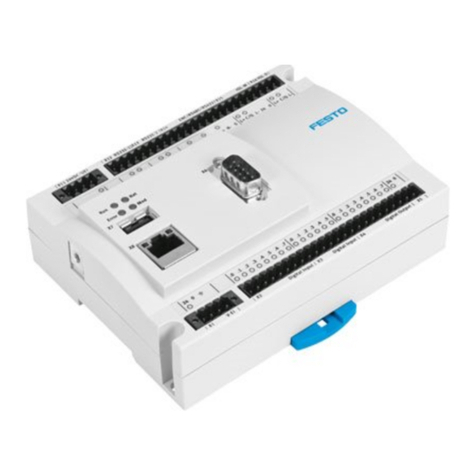
Festo
Festo Controller CECC-LK Parts list manual
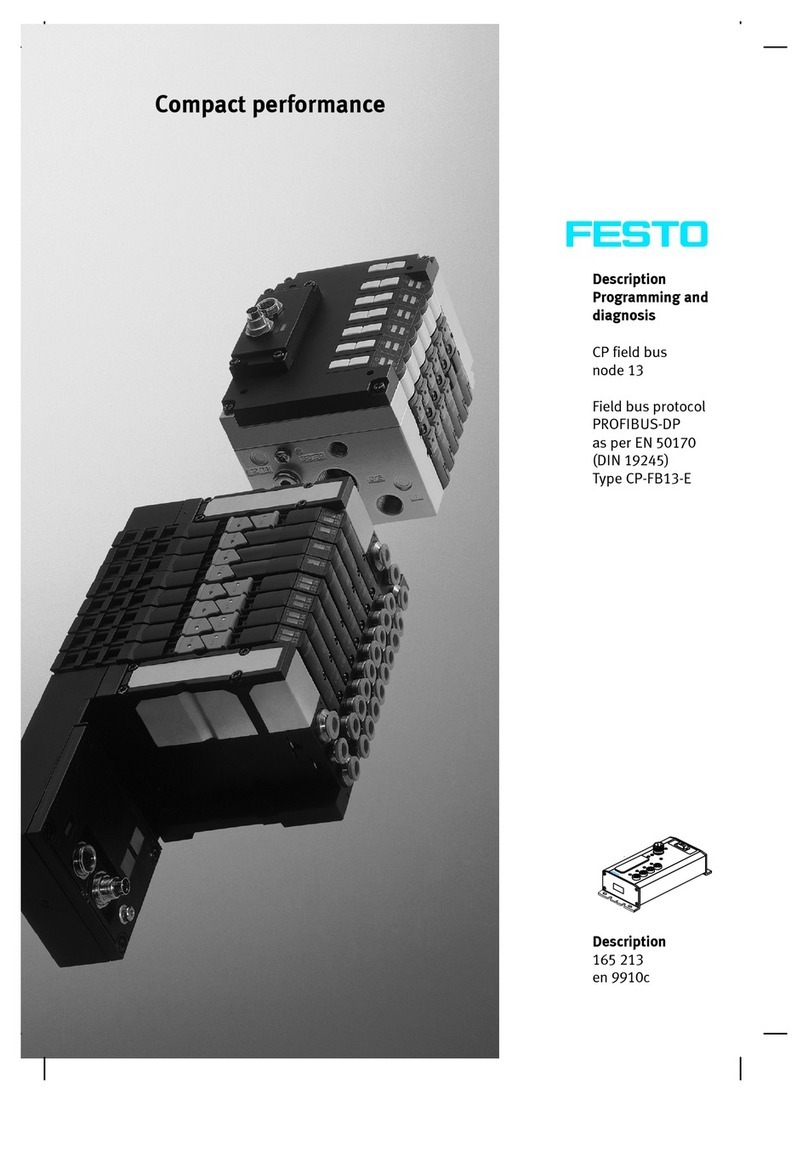
Festo
Festo CP-FB13-E User manual
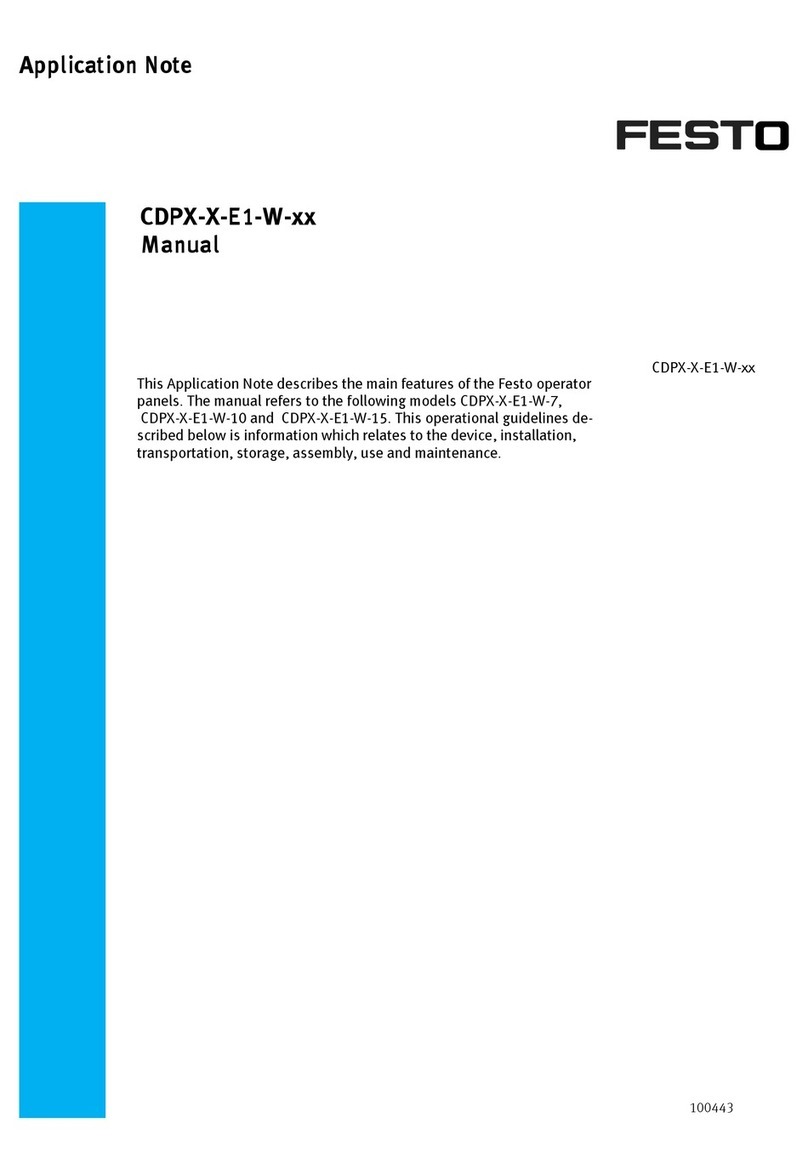
Festo
Festo CDPX-X-E1-W Series User manual
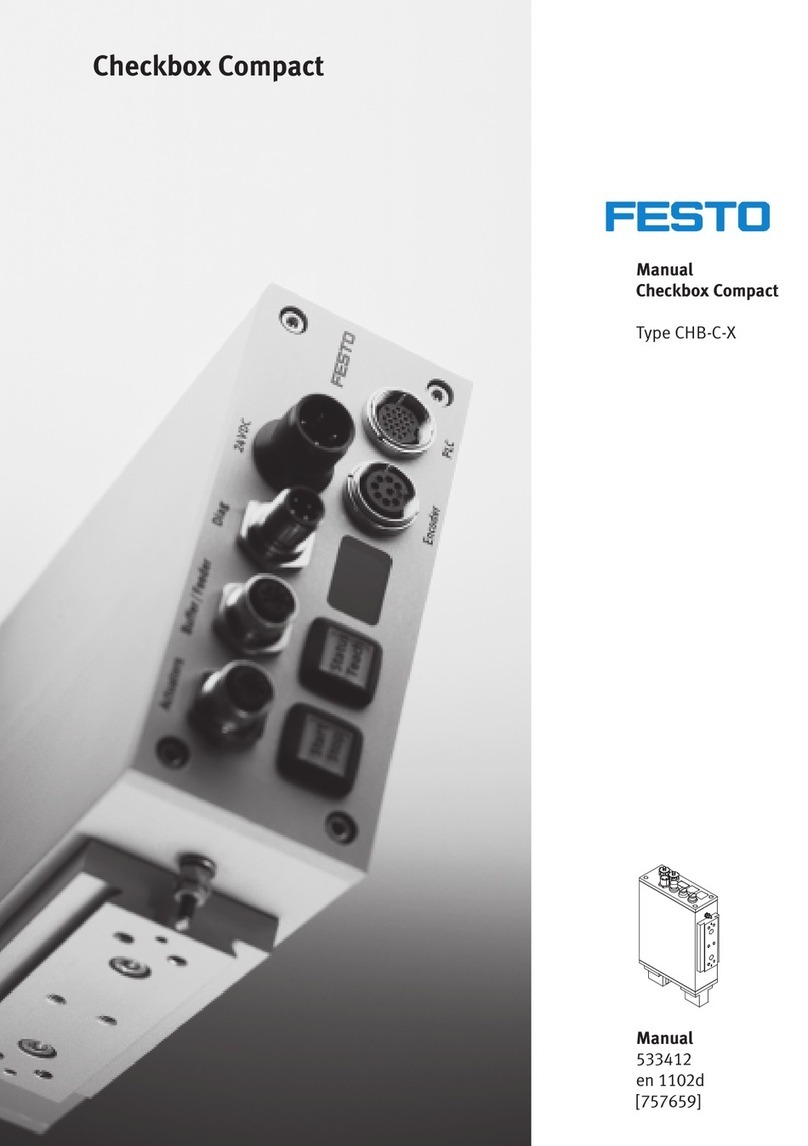
Festo
Festo Checkbox Compact CHB-C-X User manual

Festo
Festo ZSB-1/8-B User manual
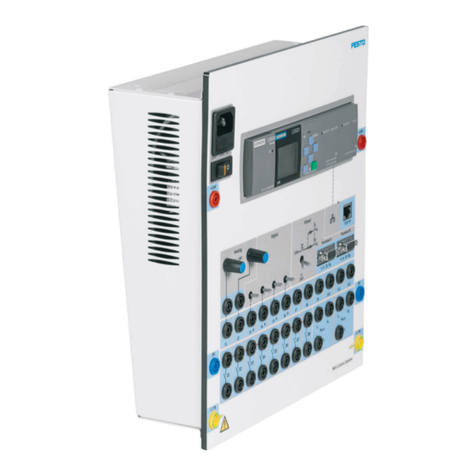
Festo
Festo EduTrainer 8071407 User manual
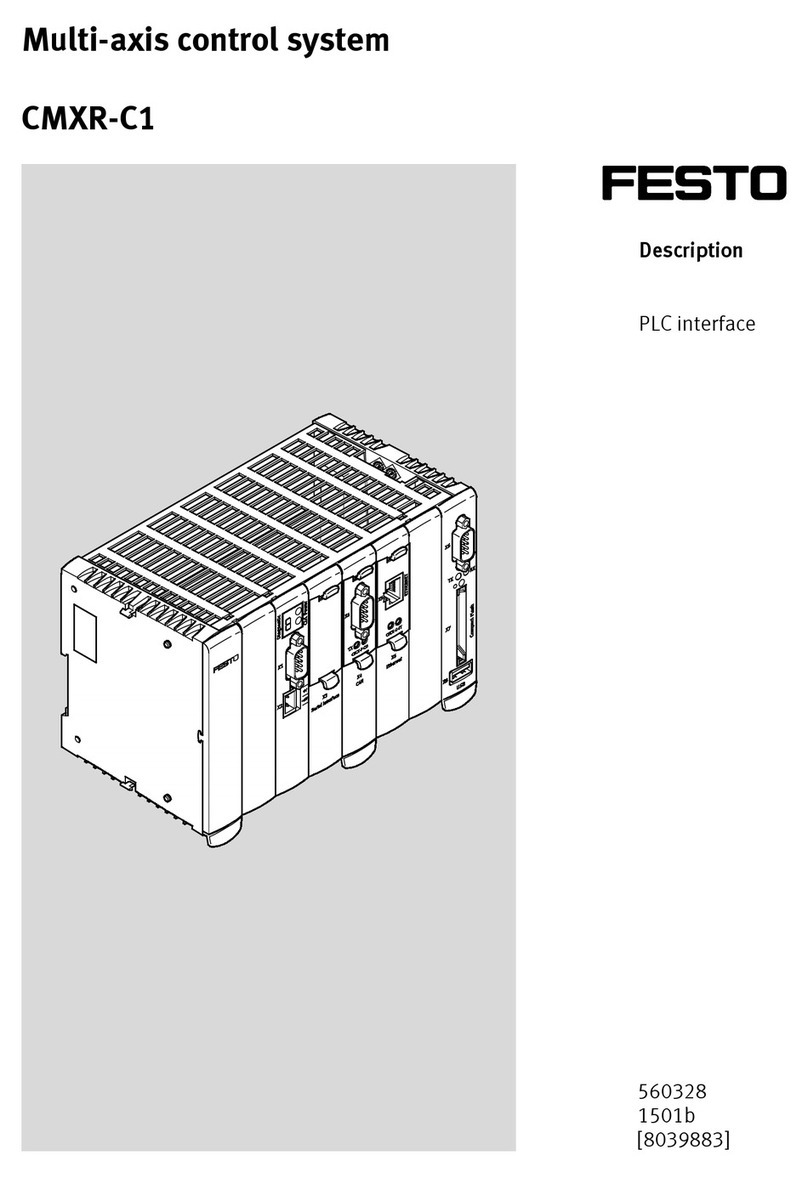
Festo
Festo CMXR-C1 Operating and installation instructions
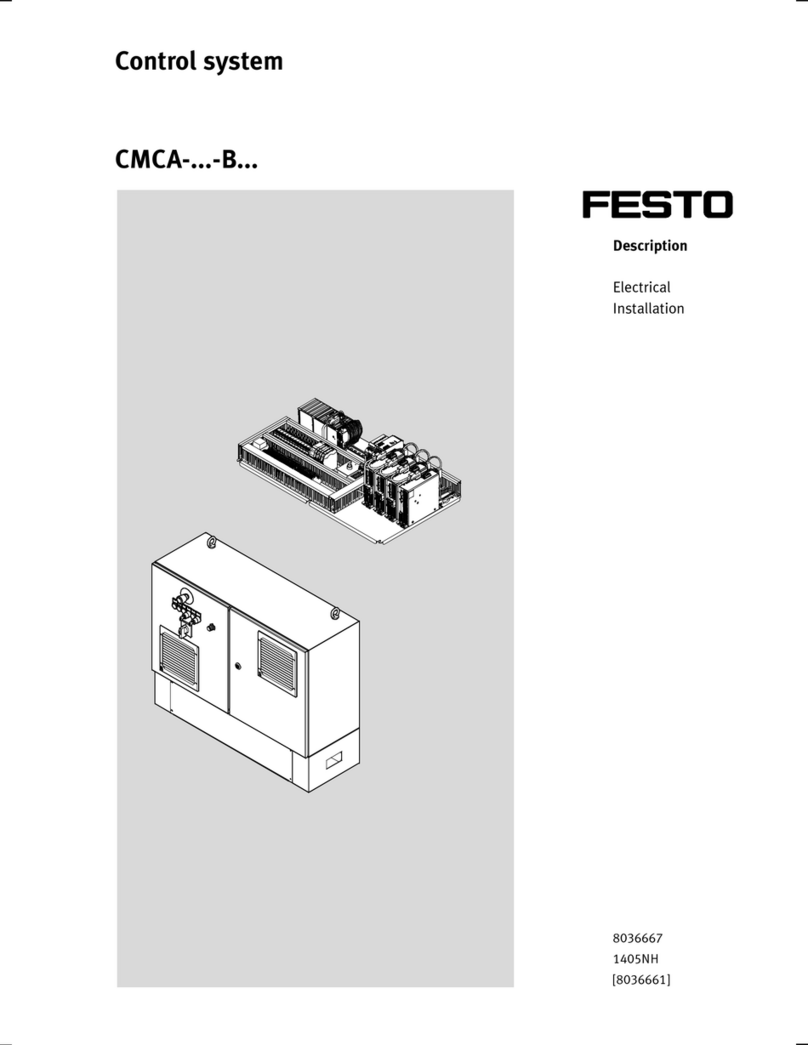
Festo
Festo CMCA-...-B Series User manual
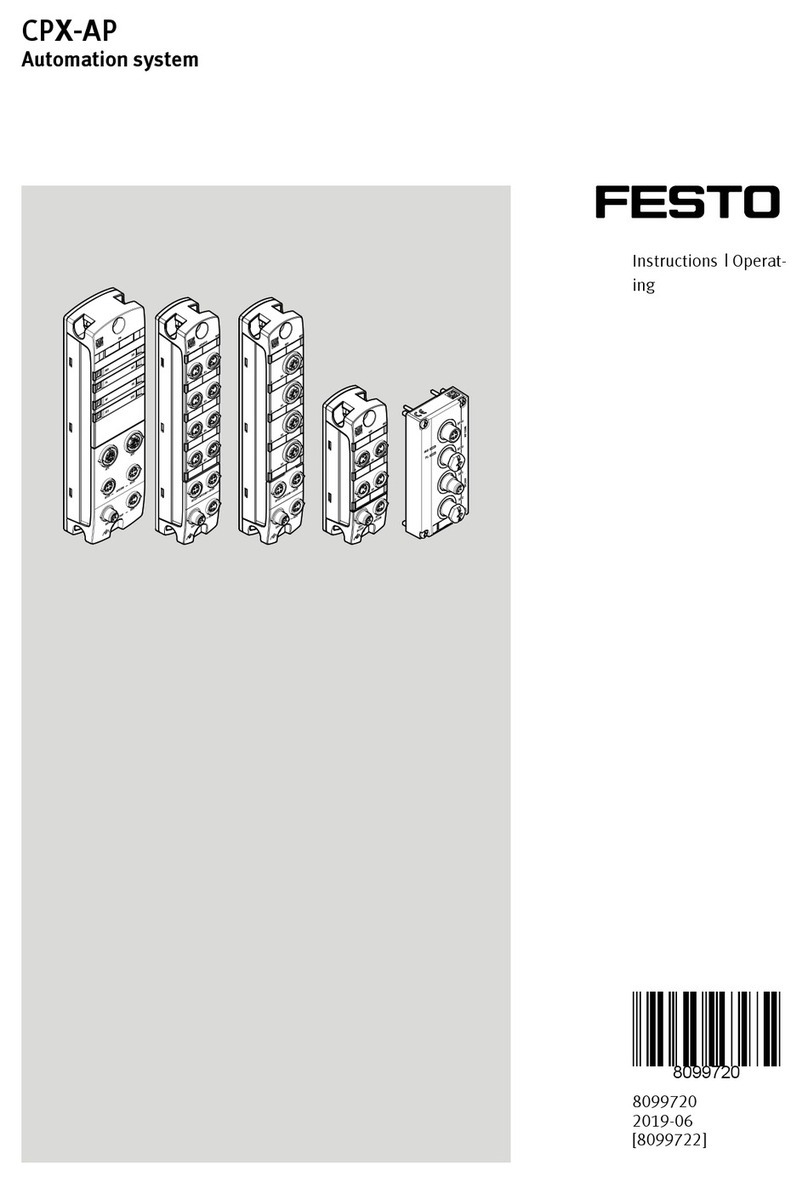
Festo
Festo CPX-AP Series User manual
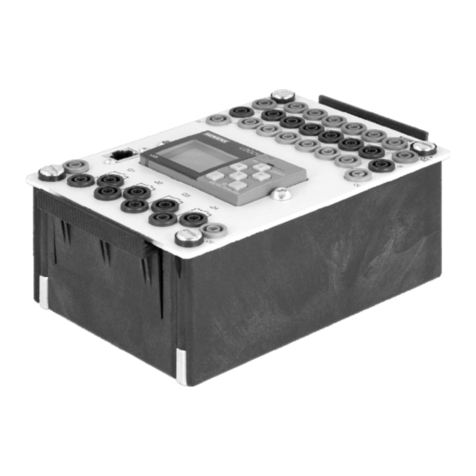
Festo
Festo LOGO! 8 TP EduTrainer User manual
